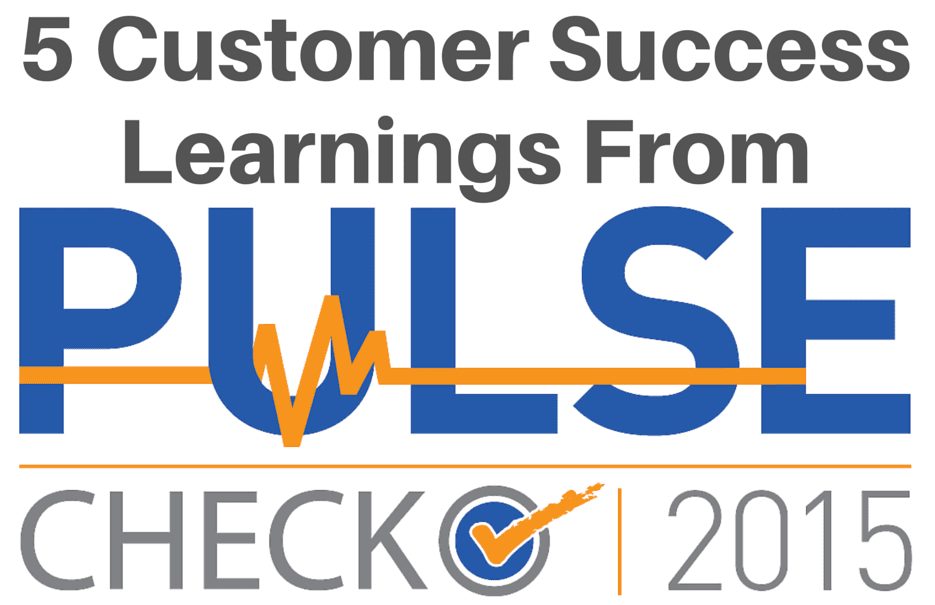PulseCheck 2015 was absolutely amazing, with nearly 2000 people from around the world tuned-in – on average for nearly 4 hours(!) – to learn from experts in customer success who covered topics both executives and customer success leaders and practitioners need to know.
And just in case you missed it or would like to go back through the sessions, you can watch the on-demand stream of PulseCheck 2015.
For me, it was great to be the host, to welcome everybody, provide some introductions for the sessions and speakers, then just sit back and be an audience member as well; to just consume all of the amazing insights from the awesome presenters.
The number of amazing takeaways from all of the sessions are really too numerous to count, but I challenged myself to come up with five things that really stood out from PulseCheck 2015.
Let’s jump into this… shall we?
1. Customer success is the path to CEO
#pulsecheck2015 SVP Customer Success as a pathway to the CEO's office? I'd agree with that
— Boris Pluskowski (@bpluskowski) July 22, 2015
This actually wasn’t the first time I’ve heard this; in fact I’ve said it before, Gainsight Chief Customer Officer Dan Steinman has said it before in his Customer Success University courses, and of course Nick Mehta, Gainsight CEO has said it before.
But this was one of the first times that I know of that this idea of Customer Success being a new path to CEO was really laid out there publicly for everybody to hear, along with a solid explanation behind it.
Given the nature of what a customer success leader has to understand, articulate, and manage around the business – and how this in many ways that parallels with the CEO does – it makes total sense that the next generation of CEOs absolutely are going to come from customer success.
In fact, that’s a prediction that I think will play out in a big way over the next few years.
2. Investors Care about NPS
From #PulseCheck2015 @rogerleevc We look at NPS as a criteria for who we invest in. The ROI of #CustomerSuccess .
— Tom Lipscomb (@TCLipscomb) July 22, 2015
Now I’ve previously written about my take on NPS (Net Promoter System) as a growth hack and we had an amazing webinar recently on the right ways to use NPS in your organization (check out the archive of that webinar for sure), so I understand just how impactful a strong NPS number is.
But what Roger Lee from Battery Ventures and Nick Mehta, Gainsight CEO, talked about was how not only are metrics like Customer Acquisition Cost (CAC) and Net Retention important to Venture Capital investors (VCs) during fundraising, but NPS is increasingly becoming a key metric in funding decisions, the collective jaw-dropping across the globe was felt for sure.
Judging by the reactions on Twitter, it seemed like many people were surprised that NPS was a metric VCs use to inform their investment decisions, so I’m glad this lesser-known aspect of fundraising was discussed publicly; it definitely adds a yet another very compelling reason to focus on customer success, even in the very early days of a company’s life.
3. Churn and Risk Mitigation Must be a Company Effort
Great point that #risk mitigation is an all company effort, not just on the #CSM – #PulseCheck2015
— Jim Jones (@jtj3tweets) July 22, 2015
I’ve said it a million times before, but customer success is an organizational effort; when you operationalize customer success through a formal customer success organization – just like support, sales, or marketing – there’s a tendency to say “oh, that’s their job.”
But just like the saying “everybody in the company is in sales” the same is true for customer success.
No, you may not all work in the customer success organization, but everybody in the company has to be aligned on helping your customers achieve their desired outcome.
In fact, it’s very difficult for a customer success organization to actually help customers achieve the desired outcome if the rest of the organization is not aligned with that goal.
Customer success cannot be achieved in a vacuum by just one part of the organization; if everything else in the organization is not set up to help the customer achieve their desired outcome, then the customer success organization is essentially set up for failure.
So this part of PulseCheck 2015 was not something that a lot of us heard for the first time, but being reminded that customer success is not just a function or a role in a company but is really everybody’s responsibility is always valuable.
And then being able to take that high-level philosophy and apply a very structured framework to it – and illustrating all of the various handoffs and touch points that actually occur with the customer across the enterprise – was just awesome.
4. Be Transparent with your Customers
Be transparent with your customers in your EBR's – it benefits not only them but your company as well #PulseCheck2015
— J. Lanore (@yellobrainfiles) July 22, 2015
This is such a powerful concept… the idea of being transparent in your Executive Business Review (EBR) or Quarterly Business Review (QBR).
Now, obviously there’s a level of transparency that can go to far and because the customer to maybe just trust you – the customer doesn’t need to know about the break room lunch-labeling fiasco of 2015 – but letting the customers know the things going on in the company that are relevant to them is very important.
Whether it’s the product roadmap, executive or key employee changes, investor investment rounds (achieved or not), etc., this level of transparency is super-important to building and maintaining trust with the customer.
And of course the side effect of your transparency with a customer – and the trust that builds – is that they will then be transparent with you.
They’ll be more open and honest about what’s going on in their world; everything from executive changes on their side, an investment issue they’re dealing with, to just how they’re actually doing with your product or how they actually feel about the relationship with your company.
Transparency begets trust, which begets transparency, and so on; it’s a beautiful thing.
The bottom line here is the more honest you are in your EBR, the more information you get from your customer, and the better able you are to help your customer continue to achieve their desired outcome.
5. Self Service is Key for Mature Organizations and Customers
You may love your CSM or support but what happens when they go on vacation? Mature customers use self-serve. Thanks @ZachB22 #PulseCheck2015
— Adam Avramescu (@avramescu) July 22, 2015
I spend a lot of time with companies of all shapes and sizes, from high-touch enterprise-type companies to those that employ a self-service model, and the one thing I’ve always said is that self-service isn’t just for small startups or for companies with “simple” products or self-service sales or customer success models.
The reality is self-service is all about scale and if you want to scale regardless of the type of company you are, building in self-service functionality at various points within your product and support systems across the entire customer lifecycle will only help you scale.
And contrary to popular belief, self-service will help even your high-touch customers achieve their desired outcome.
Maybe you wouldn’t “self-service” the entire relationship, but I’ve never seen a situation where some level of self-service wouldn’t help the customer – and the people within the customer organization – do what they need to do to achieve their desired outcome, faster.
What’s really interesting is that small startups want to build self-service in from the ground-up for everything, it’s actually the mature organizations that really understand how their customers work and know what they can – and can’t or shouldn’t – turn into self-service.
And of course self-service doesn’t refer simply to in-product interactions, but to on-demand webinars, community support systems, and 1:many emails. These tactical self-service mechanisms can be invaluable to helping a customer maintain momentum with your product even when high-touch support and customer success resources are not available (if they go on vacation, for instance).
While it’s obviously that some bigger companies or more strategic accounts need/deserve additional attention, the common refrain that one-to-many communications is just for small customers and not for big accounts is simply incorrect; and it was nice to hear that yet again from Customer Success experts.
Only The Tip of the Iceberg
Okay, so those are just 5 key learnings at PulseCheck 2015… but there was so much covered by all of the wonderful speakers and Customer Success experts that this is just the tip of the iceberg.
And if you’re like me, you couldn’t take notes fast enough, you know you missed some things, you can always go back and watch the on-demand stream of PulseCheck 2015.
And I’ll see you in October for Pulse Europe in London and in May at Pulse 2016 in San Francisco.

